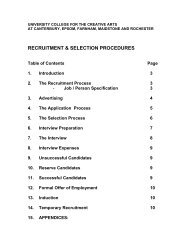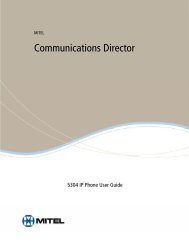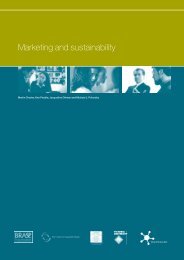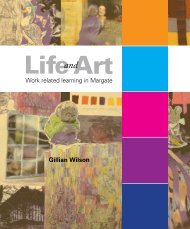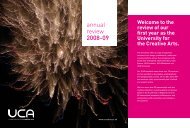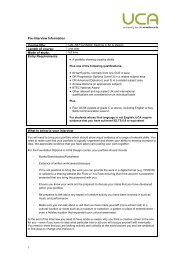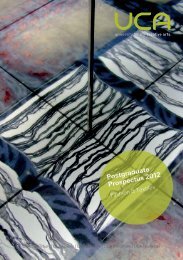John Hinchcliffe
John Hinchcliffe
John Hinchcliffe
- No tags were found...
Create successful ePaper yourself
Turn your PDF publications into a flip-book with our unique Google optimized e-Paper software.
purple palette was used on the stoneware body. <strong>Hinchcliffe</strong> discovered as aresult of the collaboration that stoneware was not suitable for the decorativeeffects that he wanted to achieve, and he focused on underglaze earthenwareand ‘majolica’. He did not use stoneware again until the 1990s in a projectwith the Dart Pottery. His work for the craft shop exhibition influenced<strong>Hinchcliffe</strong>’s later renowned Hypericum design. Tchalenko carried throughdesign ideas into her very successful work for the Dart Pottery. 26Tchalenko recalled that ‘one of the most important things about that smallexhibition was the fact of colour - of glaze and colour - that we experimentedwith’. 27 As this was Hinchliffe’s first substantial public exposure as a potter, itwas both a moment to achieve a new status in an unexpected craft form, anda brave departure from familiar ground. The exhibition at the V&A Museumcrafts shop acted as a stimulus for the developing long-term partnership withWendy Barber. It suggested that there was a substantial market for their work.The next public exhibition, this time of <strong>Hinchcliffe</strong> and Barber’s work, wasin 1983. The show of blue and white spongeware and hand-painted wareswas held at the Salisbury Arts Centre, a venue that regularly presented craftexhibitions with regional significance. The ceramics sold out completely, andpromoted the partnership to a large and enthusiastic audience. Many privatecollectors began their purchase of <strong>Hinchcliffe</strong>’s ceramics here. In the show,<strong>Hinchcliffe</strong>’s pots were shown alongside Barber’s tapestries of the topiaryand fountain at Athelhampton House in Dorset, and the apple blossomwalk at Cranborne Manor. They also promoted a textile range designed tocomplement the blue and white ceramics. Fabrics were available by the yard,or ready made as duvet covers and quilts. The affinity of the ‘surface quality’in both ceramics and textiles reinforced both makers’ belief in the importanceof presentation and the application to the domestic setting.The show led to a commission from the Salisbury Museum, the partnership’sfirst large scale museum piece. Wendy Barber painted a big tile panel at theentrance of the newly created ceramics gallery at the museum in 1985. It alsoprompted fertile relationships with retailers, keen to exploit this contemporarylook in textiles and ceramics. Mary Wiggen, the owner of Coexistence, withher household design and furniture store (then in Bath and now in Islington),was an enthusiastic champion of the work, placing it alongside her importedcontemporary Italian furniture. On a more local level, the partners sold theirwork at this time at the Christmas sales hosted by the painter and engraverRobert Tilleard from his house outside Tisbury, Wiltshire, in collaborationwith other local design and craft businesses such as the Natural Dye Companyand Compton Marbling.<strong>Hinchcliffe</strong>’s hand-painted platters for the Salisbury exhibition contain theseeds for design ideas which have remained throughout his work. Bold, freshflowers stand out against freely brush-painted blue backgrounds, occasionallybrightened with touches of yellow, adding spectacle to the plate. These flowerplates, whose designs were translated into the later Hypericum range andsome early, rare, platters with fish designs, have a sprightly sense of purpose.They indicate a potter of confidence, at ease with his new craft form, whohad learned rapidly from his partnership with Tchalenko. <strong>Hinchcliffe</strong> nowenjoyed being in control of the whole ceramic process, rather than being apainter of plates.This very first studio ware, painted by <strong>Hinchcliffe</strong> and marketed alongsidethe partnership’s textiles, still has a fresh, vibrant feel to it. The drawing andthe sponge-work match the shapes with unassuming ease. The free-paintingstyle (owing, perhaps to Barber’s artistic influence) achieves something of theeffect of watercolour on paper. The first Hypericum designs were collected20 J o h n H i n c h c l i f f e J o h n H i n c h c l i f f e 21





